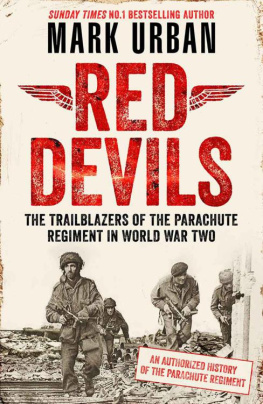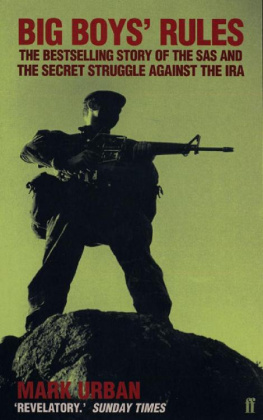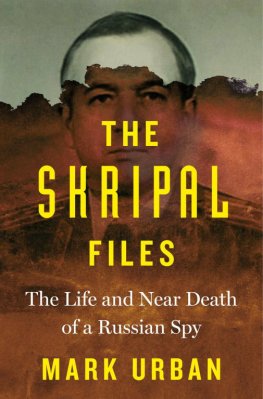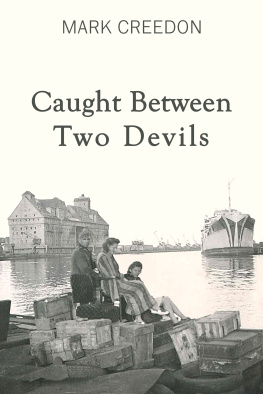Mark Urban - Red Devils
Here you can read online Mark Urban - Red Devils full text of the book (entire story) in english for free. Download pdf and epub, get meaning, cover and reviews about this ebook. year: 2022, publisher: Penguin Books Ltd, genre: History. Description of the work, (preface) as well as reviews are available. Best literature library LitArk.com created for fans of good reading and offers a wide selection of genres:
Romance novel
Science fiction
Adventure
Detective
Science
History
Home and family
Prose
Art
Politics
Computer
Non-fiction
Religion
Business
Children
Humor
Choose a favorite category and find really read worthwhile books. Enjoy immersion in the world of imagination, feel the emotions of the characters or learn something new for yourself, make an fascinating discovery.
- Book:Red Devils
- Author:
- Publisher:Penguin Books Ltd
- Genre:
- Year:2022
- Rating:4 / 5
- Favourites:Add to favourites
- Your mark:
- 80
- 1
- 2
- 3
- 4
- 5
Red Devils: summary, description and annotation
We offer to read an annotation, description, summary or preface (depends on what the author of the book "Red Devils" wrote himself). If you haven't found the necessary information about the book — write in the comments, we will try to find it.
Red Devils — read online for free the complete book (whole text) full work
Below is the text of the book, divided by pages. System saving the place of the last page read, allows you to conveniently read the book "Red Devils" online for free, without having to search again every time where you left off. Put a bookmark, and you can go to the page where you finished reading at any time.
Font size:
Interval:
Bookmark:

Mark Urban
RED DEVILS
The Trailblazers of the Parachute Regiment in World War Two: An Authorized History

Contents
About the Author
Mark Urban is the Diplomatic Editor of BBCs Newsnight programme and was formerly defence correspondent for the Independent. He formerly served in the British Army, both in the Royal Tank Regiment and in the Territorial Army. He is the author of several books, including Rifles, The Skripal Files and Task Force Black (a Sunday Times number-one bestseller).
For Gina and LilyIllustrations
Lieutenant Colonel Johnny Frost, while he was CO of the 2nd Battalion. Lieutenant Jack Grayburn of the 2nd Parachute Battalion. Sergeant Major Macleod Maxie Forsyth, one of the pre-war regular NCOs who joined the fledgling airborne forces. Corporal Arthur Maybury, a pioneer member of the 2nd Battalion who later went into intelligence work. Lieutenant Colonel Richard Geoffrey Pine-Coffin, on the day in 1945 that he took his son to Buckingham Palace. Sergeant Mike Lou Lewis, another early member of the 2nd Battalion, who became a gifted war photographer. Sidney Cornell was decorated and promoted for his bravery in Normandy fighting with the 7th Parachute Battalion. Lieutenant Richard Dicky Spender, a poet who discovered that he relished war while fighting with the 2nd Battalion in Tunisia. Major General Richard Windy Gale was instrumental in defining the command culture of the new regiment.Brigadier Gerald Lathbury commanded the 1 st Parachute Brigade in Sicily and at Arnhem.
Probably the most storied wartime commander in the Parachute Regiment, Alastair Pearson was awarded the Distinguished Service Order four times.
Midwife to the Parachute Regiment and Airborne Forces more widely, Lieutenant General Frederick Boy Browning had a network of military and political contacts second to none.
This low-level photograph taken by Flight Lieutenant Tony Hill revealed the Wrzburg radar and nearby chateau, providing the start point for Operation Biting.
Quayside crowds in Portsmouth greeting Johnny Frosts returning men after the Bruneval raid.
Wing Commander Charles Pickard, who led the formation of Whitley bombers to the Bruneval drop, with men of the 2nd Battalion and a trophy of the raid.
One of the many synthetic training devices adopted to prepare men for their first drop and make up for the shortage of suitable aircraft was the fan trainer, which allowed practice landings at different speeds.
At Hardwick Hall, would-be recruits to the Parachute Regiment were put through extensive physical training, both on the assault course and with repeated route marches.
Having passed Hardwick, aspirant paratroopers were sent to No. 1 Parachute School at Ringway, near Manchester, where they practised all aspects of jumping before making their first drop from a balloon.
Another view of training at Ringway: knees together, elbows in, students learn how to land without injury.
A pre-deployment tea with (left to right) Arthur Chalky White, Maud Selman, her son Fred Selman, and Mike Lou Lewis.
Officers from A Company of the 2nd Battalion after the Oudna debacle: Captain Ronald Stark, Lieutenant Desmond Slapsey Brayley and Major Dick Ashford, who sports a non-regulation beret picked up from French stores.
The arduous Tunisian campaign exposed the men to the rigours of a North African winter while moving to one threatened sector after another to thwart enemy advances. This photo features the 1st Parachute Battalion.
This aqueduct in the Tamera valley provided a landmark in the Tunisian landscape and a rallying point for these 1st Battalion men after a night patrol.
General Dwight Eisenhower visits the 1st Parachute Brigade in May 1943, soon after its return from the Tunisian front. Airborne forces figured prominently in his plans for the next stage of the war.
The Tunisian campaign was distinguished by several battles between British and German paratroopers, who here had captured Private Gavin Cadden, a veteran of Dunkirk and Bruneval whose luck ran out at Oudna.
After posting to the Army Film and Photographic Unit, Mike Lewis put up sergeants stripes and was here pictured by a memorial to those, including so many of his friends, who had fallen in the Tunisian battles.
Containers for dropping stores by parachute being prepared in the run-up to 1st Airborne Divisions operations in Sicily.
A model maker puts finishing touches to a diorama used for briefing the men of 1st Parachute Brigade about their target in Sicily, the Primosole Bridge.
General Windy Gale in full flow, giving 6th Airborne Division a pep talk prior to D-Day.
Men of the 22nd Independent Parachute Company synchronize their watches prior to taking off from RAF Harwell in Oxfordshire.
Members of the 225th Parachute Field Ambulance, crammed into a Stirling bomber on their way to Normandy.
Gliders and their Stirling tugs at RAF Tarrant Rushton.
Drop Zone N became Landing Zone N as scores of gliders landed there on 6 June 1944, there being 355 of them dispatched in support of 6th Airborne Division, mostly carrying heavy equipment and stores.
Critical to the success of Operation Tonga, was the landing of a coup de main party on the night of 5/6 June adjacent to the bridges over the Orne and the nearby canal. Four of the six assigned Horsas landed close to their targets, deploying assault troops.
Passengers on a Horsa dubbed Charlies Aunt wasted no time unloading the jeep and cargo trailer on board.
Troops crossing the canal bridge at Bnouville. Once taken by airborne forces, it became an important asset for moving men and equipment within the Allied bridgehead.
Another jeep-and-trailer combination speeds into action, this heavily laden vehicle belonging to 6th Airborne Divisions Royal Army Service Corps company, which delivered supplies.
A pair from the 6th Airborne Divisions provost (or military police) company guarding a junction near Ranville in the airborne bridgehead.
Men of No. 4 Commando linking up with paratroops from the 7th Battalion in Bnouville on 6 June 1944.
Panzer IVs of the 21st Panzer Division were used to launch a number of counter-attacks against 6th Airborne Division.
Men of 6th Airlanding Brigade pictured a few days after the Normandy landings in nearby Bnouville.
Many of the fallen were initially interred in Normandy graveyards, in this case three men of the 7th Parachute Battalion and a member of the Royal Engineers.
The sky full of aircraft and parachutes above the Dutch countryside on 17 September 1944, as Operation Market Garden got underway. This remarkable image was captured by a reconnaissance Spitfire.
Men of the 1st Battalion, the Border Regiment, one of the airlanded battalions that arrived to the west of Arnhem on the first day of the operation.
Sergeant Mike Lewis captured film of Dutch locals greeting their liberators. This still shows members of 21st Independent Parachute Company (including the sergeant, who jumped with his arm in plaster) and one 3rd Battalion man.
A party of German prisoners captured soon after the landings being escorted near the Wolfheze asylum, about ten kilometres north-west of Arnhem.
An aerial view showing the elevated roadway leading off the main bridge at Arnhem with the burnt-out remnants of the SS column that was ambushed there on the morning of 18 September 1944.
A German photographer in Arnhem snapped these captured British paratroopers being led away.
Next pageFont size:
Interval:
Bookmark:
Similar books «Red Devils»
Look at similar books to Red Devils. We have selected literature similar in name and meaning in the hope of providing readers with more options to find new, interesting, not yet read works.
Discussion, reviews of the book Red Devils and just readers' own opinions. Leave your comments, write what you think about the work, its meaning or the main characters. Specify what exactly you liked and what you didn't like, and why you think so.














